Related Research Articles

Sheba is a kingdom mentioned in the Hebrew Bible and the Quran. Sheba features in Jewish, Muslim, and Christian traditions, particularly the Ethiopian Orthodox Tewahedo tradition. It was the home of the biblical "Queen of Sheba", who is left unnamed in the Bible, but receives the names Makeda in Ethiopian and Bilqīs in Arabic tradition. According to Josephus it was also the home of the biblical "Princess Tharbis" said to have been the first wife of Moses when he was still a prince of Egypt.
The Sabaeans or Sabeans were an ancient South Arabian people of South Arabia. They spoke the Sabaean language, one of the Old South Arabian languages. They founded the kingdom of Sabaʾ in modern-day Yemen, which was believed to be the biblical land of Sheba and "the oldest and most important of the South Arabian kingdoms".

D mt was a kingdom located in Eritrea and northern Ethiopia that existed between the 10th and 5th centuries BC. Few inscriptions by or about this kingdom survive and very little archaeological work has taken place. As a result, it is not known whether Dʿmt ended as a civilization before the Kingdom of Aksum's early stages, evolved into the Aksumite state, or was one of the smaller states united in the Kingdom of Aksum possibly around the beginning of the 1st century.
Malik, Mallik, Melik, Malka, Malek, Maleek, Malick, Mallick, or Melekh is the Semitic term translating to "king", recorded in East Semitic and Arabic, and as mlk in Northwest Semitic during the Late Bronze Age.

The Himyarite Kingdom, or Himyar, historically referred to as the Homerite Kingdom by the Greeks and the Romans, was a polity in the southern highlands of Yemen, as well as the name of the region which it claimed. Until 110 BCE, it was integrated into the Qatabanian kingdom, afterwards being recognized as an independent kingdom. According to classical sources, their capital was the ancient city of Zafar, relatively near the modern-day city of Sana'a. Himyarite power eventually shifted to Sana'a as the population increased in the fifth century. After the establishment of their kingdom, it was ruled by kings from dhū-Raydān tribe. The kingdom was named Raydān.
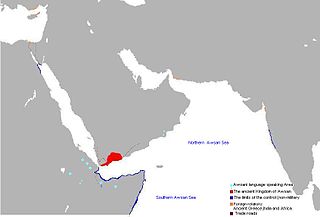
The ancient Kingdom of Awsān in South Arabia, modern-day Yemen, with a capital at Ḥajar Yaḥirr in Wādī Markhah, to the south of Wādī Bayḥān, is now marked by a tell or artificial mound, which is locally named Ḥajar Asfal. Once it was one of the most important small kingdoms of South Arabia. The city seems to have been destroyed in the 7th century BCE by the king and Mukarrib of Saba' Karab El Watar, according to a Sabaean text that reports the victory in terms that attest to its significance for the Sabaeans.
A chiefdom is a form of hierarchical political organization in non-industrial societies usually based on kinship, and in which formal leadership is monopolized by the legitimate senior members of select families or 'houses'. These elites form a political-ideological aristocracy relative to the general group.
Abraha, also known as Abrahah al-Ashram, was an Aksumite army general, then the viceroy of South Arabia for the Kingdom of Aksum, and later declared himself an independent King of Himyar. Abraha ruled much of present-day Arabia and Yemen from at least 531–547 CE to 555–570 CE.

Habesha peoples is an ethnic or pan-ethnic identifier that has been historically employed to refer to Semitic language-speaking and predominantly Orthodox Christian peoples found in the highlands of Ethiopia and Eritrea between Asmara and Addis Ababa and this usage remains common today. The term is also used in varying degrees of inclusion and exclusion of other groups.
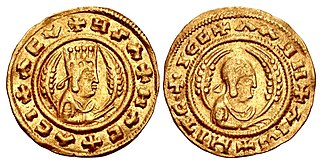
Aksumite currency was coinage produced and used within the Kingdom of Aksum centered in present-day Eritrea and Ethiopia. Its mintages were issued and circulated from the reign of King Endubis around AD 270 until it began its decline in the first half of the 7th century. During the succeeding medieval period, Mogadishu currency, minted by the Sultanate of Mogadishu, was the most widely circulated currency in the Horn of Africa.

Pre-Islamic Arabia refers to the Arabian Peninsula before the emergence of Islam in 610 CE.

The Minaean people were the inhabitants of the kingdom of Ma'in in modern-day Yemen, dating back to the 10th century BCE-150 BCE. It was located along the strip of desert called Ṣayhad by medieval Arab geographers, which is now known as Ramlat Dehem.

The Hashid is a tribal confederation in Yemen. It is the second or third largest – after Bakil and, depending on sources, Madh'hij – yet generally recognized as the strongest and most influential. According to medieval Yemeni genealogies, Hashid and Bakil were the sons of Jashim bin Jubran bin Nawf Bin Tuba'a bin Zayd bin Amr bin Hamdan. Member tribes of the Hashid Confederation are found primarily in the mountains in the North and Northwest of the country.
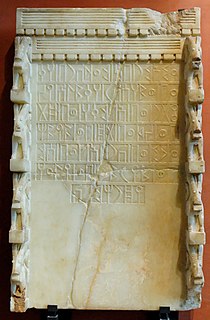
The ancient history of Yemen is especially important because Yemen is one of the oldest centers of civilization in the Near East. Its relatively fertile land and adequate rainfall in a moister climate helped sustain a stable population, a feature recognized by the ancient Greek geographer Ptolemy, who described Yemen as Eudaimon Arabia meaning Fortunate Arabia or Happy Arabia. Between the eighth century BCE and the sixth century CE, it was dominated by six main states which rivaled each other, or were allied with each other and controlled the lucrative spice trade: Saba', Ma'īn, Qatabān, Hadhramaut, Kingdom of Awsan, and the Himyarite Kingdom. Islam arrived in 630 CE and Yemen became part of the Muslim realm.
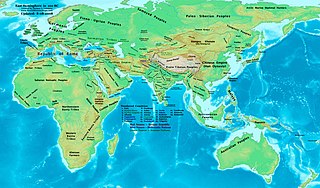
Qataban was an ancient Yemeni kingdom which existed from the early 1st millennium BCE till the late 1st or 2nd centuries CE.

Banu Hamdan is a well known Sabaean clan that dates back to the 1st millennium BCE. The clan is located in Yemen. It was mentioned in Sabaic inscriptions as qayls of Hashid, who later acquired control over a part of Bakil and finally gave their clan name to tribal confederations including Hashid and Bakil.
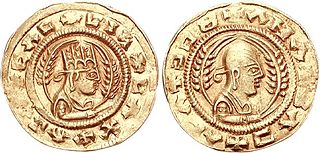
The Kingdom of Aksum, also known as the Kingdom of Axum or the Aksumite Empire, was a kingdom centered in Northeast Africa and South Arabia from Classical antiquity to the Early Middle Ages. Based primarily in what is now northern Ethiopia, and spanning modern-day Eritrea, northern Djibouti, and eastern Sudan, it extended at its height into much of modern-day southern Arabia during the reign of King Kaleb.
Kaminahu is the name of an ancient South Arabian city in the northern al-Jawf region of present day Yemen, 107 km north-east of Sana'a at about 1100 meters above sea level.
Nashan is the name of an ancient South Arabian city in the northern al-Jawf region of present day Yemen, in the territory of the ancient Kingdom of Ma'in. The city was called Nestum in the Natural History book that was written by Pliny the Elder.

The Kings of Persis, also known as the Darayanids, were a series of Persian kings, who ruled the region of Persis in southwestern Iran, from the 2nd century BCE to 224 CE. They ruled as sub-kings of the Parthian Empire, until they toppled them and established the Sasanian Empire. They effectively formed some Persian dynastic continuity between the Achaemenid Empire and the Sasanian Empire.
References
- ↑ Gzella, Holger (2011). Languages from the World of the Bible. Walter de Gruyter. ISBN 978-1-934078-63-1.
- ↑ Munro-Hay, Stuart (2002). Ethiopia, the Unknown Land: A Cultural and Historical Guide. I.B.Tauris. ISBN 978-1-86064-744-4.
- ↑ E.g. Korotayev A. Apologia for ‘the Sabaean cultural-political area’. Bulletin of the School of Oriental and African Studies, 57/3 (1994), 469-474.
- ↑ McCorriston, Joy (2011). Pilgrimage and Household in the Ancient Near East. Cambridge University Press. ISBN 978-0-521-76851-1.